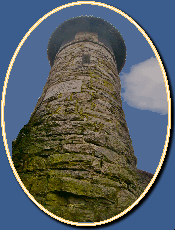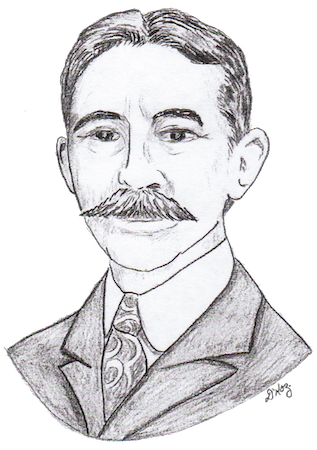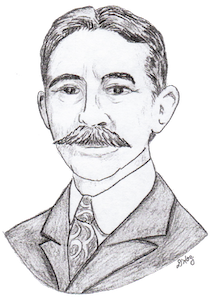The father of conservation
George Bird Grinnell – who is known throughout the world as an anthropologist, historian, naturalist, mineralogist, explorer, sportsman and conservationist – would have been a household name in Milford if John F. Kennedy had not been assassinated. In 1963, the superintendent of Milford schools, Joseph A. Foran, proposed that the new grammar school being planned for West Avenue across Mondo Pond from the Grinnell farm be named for him. When Kennedy was killed in November 1963, the decision was made to name the new school the John F. Kennedy Elementary School which opened in 1966. This was the end of a tradition of naming local schools after well-known residents (e.g. Fannie Beach, Jonathan Law, Simon Lake, Joseph A. Foran).
Grinnell was born in Brooklyn on September 20, 1849, then moved as a child with his family to Manhattan. Grinnell’s father, George Blake Grinnell, having made his fortune as a stock broker and investment banker, bought property at the intersection of what is now Naugatuck Avenue and Grinnell Street in Milford to start a farm. He built a grand Italianate-style estate house in 1865. According to Milford resident Joan Saloomey, who currently lives on part of the Grinnell estate, when her grandfather bought the property from Grinnell’s father in 1922, there were vegetable fields, most notably corn and potatoes, as well as cherry, peach and pear orchards, formal gardens and three large ponds. It was called Beaverbook Farm.
With the middle name of Bird, G.B. Grinnell may have been destined to become an ornithologist, among other things. He grew up in Audubon Park in Washington Heights, Manhattan, on the 20-acre estate of John James Audubon, author of Birds of America. As a boy, Grinnell was fascinated with the preserved animal and bird collections, as well as the travels of Audubon and his son, John Woodhouse Audubon.
As a child, Grinnell had enjoyed seeing the flight of passenger pigeons from his bedroom window in New York, and he watched helplessly as the entire passenger pigeon population became extinct. Motivated by his desire to prevent the demise of other bird species, Grinnell helped found the first Audubon Society in 1886. It was officially incorporated in 1905 and named in honor of John James Audubon.
Grinnell studied ornithology and paleontology at Yale, graduating with a B.A. in 1870 and a Ph.D. in 1880. He worked as a graduate assistant at the Peabody Museum in New Haven. Grinnell initially specialized in zoology. In 1895, he helped found the New York Zoological Society – now the Wildlife Conservation Society based at the Bronx Zoo. But he later gained fame as an early conservationist and expert on Native Americans and the northern plains.
Grinnell spent years studying the natural history of the American West and became an expert on Native Americans, living with them for long periods of time. He wrote about the culture and destruction of the Indians, particularly the Cheyenne, Pawnee and Blackfeet Indians. He was pained by the destruction of the native tribal life by white settlers.
In 1870 he joined Lieutenant Colonel George Armstrong Custer’s cavalry as the official zoologist, and went on the Black Hills expedition in 1874. Luckily, he declined a similar expedition to Little Big Horn in 1876.
Grinnell lobbied Congress for the preservation of the American buffalo and conservation projects. Grinnell, a sportsman and hunter who understood the need to preserve wildlife, was friends with then President Theodore Roosevelt. They discussed the need for conservation, the preservation of American land, and laws creating and maintaining national parklands. He believed the national park system would help preserve and protect the landscapes, natural species and plants from miners, real estate moguls, hunters, loggers and tourists.
In 1887, Roosevelt and Grinnell founded the Boone and Crockett Club dedicated to preserving the heritage of hunting, promoting ethical hunting and supporting America’s wildlands. The club still exists today. Grinnell advocated a game management system of hunting, in which small fees from hunters would support a game warden to provide effective enforcement of game laws. His belief in hunting regulation was revolutionary at the time. Similarly, he was an advocate for timberland management.
Glaciers were another of Grinnell’s passions. He made numerous hunting trips to the St. Mary Lakes region of Montana in the 1880s and ‘90s, with James Willard Schultz, a professional guide. In 1885, they observed the glacier along the Swiftcurrent Valley that is now named for him. Grinnell was influential in legislation that led to the establishment of Glacier National Park in 1910.
Grinnell was an activist in movements to preserve wildlife and conservation in the American West. For many years, he published articles and lobbied for congressional support for the endangered American buffalo. Much like his chronicling of the Plains tribes, he also recorded the history of the buffalo and their relationship to Plains tribal culture.
With the passage of the 1894 National Park Protective Act, the remaining 200 wild buffalo in Yellowstone National Park received much needed protection. But it was almost too late for the species. Poaching continued to reduce the animal’s population, which declined to 23 in 1902. Grinnell’s efforts led to the Department of Interior finding additional animals in the wild and managing herds to supplement those in Yellowstone. This ultimately led to the survival of the species.
Grinnell was longtime owner and editor of Forest and Stream Magazine from 1876 to 1911. He was an avid writer, with more than two dozen books on Native Americans the Pawnee, the Blackfeet, hunting, duck shooting, the buffalo, the Great West, Alaska and others including a two-volume history of the Cheyenne.
Between his natural history and Native American studies and expeditions, Grinnell spent time in Milford, boating and bird watching on the Housatonic River and hunting ducks in the marshes. He also spent many months in Milford recovering from Rocky Mountain spotted fever.
For many years, the 22-room Grinnell house – at 94 Grinnell Street – was owned by Saloomey’s aunt, who wanted to divest herself of the property in the 1980s. Local efforts to preserve the house failed and in 1983 a local developer purchased it, gutted it and turned it into what is today the Audubon Manor Condominiums. According to Saloomey, the loss of the Grinnell family home was terrible. “Gone were the beautiful rooms with their own fireplaces, the beautiful millwork throughout the house, rosettes in the center of the ceilings, the wide mahogany staircase that went up all three stories and the lover’s nook under the staircase. It was a beautiful, mysterious house,” she recalled.
Most of the estate’s outbuildings are gone too, except the 4,000-sqaure-foot carriage house at 96 Grinnell Street, where Saloomey and her sister Karen live. The carriage house was built in 1910 to house horses and carriages and the farmhands who lived upstairs. Saloomey has fond memories of the Grinnell home, including sliding down the two-story banister. She remembers that her grandmother kept all the stuffed birds that were in the house and was known to say, “George Bird Grinnell would shoot anything that moved.”
George Bird Grinnell died on April 11, 1938, and is buried in Woodlawn Cemetery in the Bronx.



